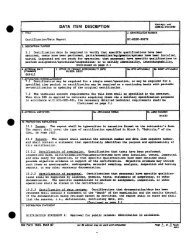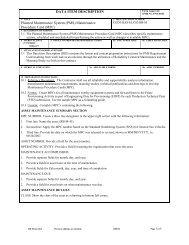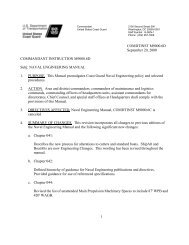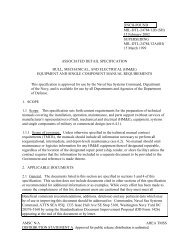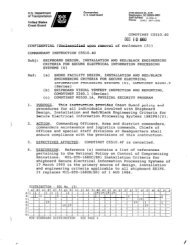NAVAIR INSTRUCTION 4120.11 From: Commander, Naval Air ...
NAVAIR INSTRUCTION 4120.11 From: Commander, Naval Air ...
NAVAIR INSTRUCTION 4120.11 From: Commander, Naval Air ...
- No tags were found...
You also want an ePaper? Increase the reach of your titles
YUMPU automatically turns print PDFs into web optimized ePapers that Google loves.
<strong>NAVAIR</strong>INST <strong>4120.11</strong><br />
IETP tech data is displayed in a non-document formatted fashion.<br />
There are high levels of interactivity between the data and the<br />
user. The sequence of presentation is dictated by inputs from<br />
the user, external sources or events (as in diagnostics). Nonlinear<br />
databases, if populated correctly, can also provide<br />
tremendous life cycle savings due to data reuse.<br />
HORIZONTAL AXIS<br />
Using the horizontal axis, identify the data types required.<br />
• The data types and the level of detail to be acquired<br />
should be commensurate with the maintenance philosophy<br />
for the weapon system or equipment. Inputs from the<br />
training command should also be considered in areas<br />
where there may be some training or courseware<br />
functionality that may be accommodated by the use of<br />
ETMs. Legacy TMs (if available) for the weapon system<br />
or a similar system should be considered as a guide<br />
for selecting data types.<br />
• It should be understood that different weapons systems<br />
will have different needs relative to data types. The<br />
Functionality Matrices attached provide examples of<br />
common data types used by weapons systems.<br />
Customization of the data types by the acquisition<br />
activity is expected.<br />
The Complexity Factor is a relatively weighted number assigned<br />
to each feature within the functional categories to indicate the<br />
abstracted complexity of a listed ETM feature when compared<br />
against the other features within that Functionality Category.<br />
A 1.0 factor being used as the baseline value for all<br />
measurements with all other factor values being a projected<br />
complexity of the listed value times greater then 1.0. For<br />
example, the ‘Key Word Search’ feature of the “Navigational”<br />
Functional Category is listed as a 1.0 feature, while the<br />
‘Access by Modification’ feature is listed as a 1.5 feature.<br />
This would mean that the ‘Access by Modification’ feature is<br />
considered one and half times as difficult to develop as the<br />
‘Key Word Search’. But the ‘Network Distribution’ feature also<br />
listed as a 1.5 feature is not comparable for complexity<br />
measurement against either the ‘Key Word Search’ or the ‘Access<br />
by Modification’ features because it is in the “Distribution”<br />
Functional Category and both of the others are in the<br />
“Navigational” Functional Category.<br />
Enclosure (2) 4





